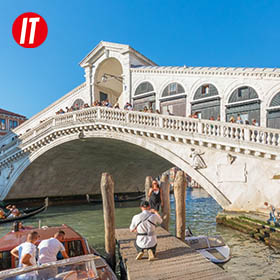Grand Canal Venice
Soul of Floating City
The Grand Canal of Venice is about 4km long and runs in a flipped S shape through the city. The Grand Canal is the busiest waterway in Venice, with water buses and gondolas shuttling day and night under the Rialto Bridge, and over 170 historic buildings on both sides of the canal.
The Grand Canal of Venice is a Filpped S-shaped Waterway about 4km long and winds through Venice. From St. Lucia Station at the northern end to the famous St. Mark’s Square (Piazza San Marco) at the southern end.
The Grand Canal, known as Venice’s mother river, varies in width from 30 to 90 meters. It has only four bridges due to the overdeveloped water traffic. Built in 1588, the Rialto Bridge (Ponte di Rialto) is located at the first bend of the river and is the oldest bridge above the Grand Canal; the Academy Bridge (Ponte dell'Accademia) is made of steel and wooden planks, guarding the southern outlet and overlooking the dome of the Basilica of Saint Mary of Health (Basilica di Santa Maria della Salute); the Barefoot Bridge (Ponte degli Scalzi) next to the Santa Lucia Railway Station is a stone arch bridge, built in 1934, named after the Church of Barefoot at the head of the bridge; the latest Constitution Bridge (Ponte della Costituzione) is very close to the Barefoot Bridge, and people have mixed feelings about this modern-style bridge.

Rialto Bridge
Venice's First Bridge
The Rialto Bridge was completed in 1591, and this white stone arch bridge is the earliest bridge to appear on the Grand Canal in Venice. For centuries the Rialto Bridge was the commercial and trade center of Venice, and today the shops above and around the bridge are very popular with visitors.

Ponte dell'Accademia
Wooden Arch Bridge over the Grand Canal
The Academy Bridge, one of the four bridges over the Grand Canal in Venice, is located on the south side of the river near the mouth, has been renovated and rebuilt several times in its history. The Academy Bridge is built on a steel-framed arch, and the bridge deck is made of wooden planks.
The Grand Canal is the busiest of Venice’s waterways and is an important part of the city’s water transport network, with a high level of traffic from both large and small vessels. Not only does it connect the city’s major attractions and transport hubs, but it is also a popular tourist destination. There are many ways to visit the Grand Canal, you can choose from the most common water bus to a high-end private yacht. But the most distinctive one is the Gondola.
Manywhere Trivia:
Don’t underestimate the Gondola, it’s known as water Ferrari, because of its super-high cost. You can also take a Gondola trip outside Italy, like the Grand Canal Shoppes Macau, China.
More than 170 historic buildings, mostly built between the 13th and 18th centuries, stand on the banks of the Grand Canal in Venice, reflecting the city’s architectural history over the last centuries. The Fondaco dei Turchi is a Byzantine-style building dating from the 13th century and currently used as the Natural History Museum of Venice. One of the finest buildings along the Grand Canal, Ca' d'Oro (Palazzo Santa Sofia) began in the 1430s and was built in Gothic style with gilded facades and frescos. A number of Baroque-style buildings appeared in Venice during the 17th century, Ca' Rezzonico is among the most iconic ones.
Attractions around the Grand Canal in Venice
- Rialto Bridge
- Ponte dell'Accademia
- Santa Maria Gloriosa dei Frari
- St. Mark's Square And St. Mark's Basilica
Tags:
Related
Hungarian Parliament Building360
A National Landmark By the DanubeSri Mariamman Temple360
Oldest Hindu Temple in SingaporeThe Palace Museum - Hall of Martial Valor360
Wuying PalaceShirakawa Village - Wada House360
Largest Gasshozukuri in ShirakawaMunich Residence And Court Garden360
Former Palace of the Monarchs of BavariaSchonbrunn Palace And Garden360
Empress Sisi's Summer ResidencePantheon360
2,000 Year Old Architectural MarvelLanna Folklife Museum360
Past Days of Lanna KingdomYokohama Park And Yokohama Stadium360
Baseball Field and Japanese GardenLeaning Tower Of Pisa360
The Failed Architectural WonderNikko Rinnoji Temple360
World Heritage Temple ComplexMusee de l'Orangerie360
Water Lilies by Impressionist Monet



























No comments yet, post the first one!